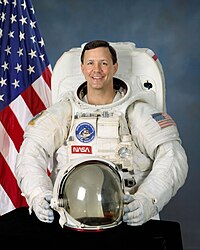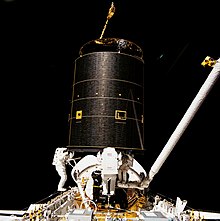Pierre J. Thuot
| Pierre Thuot | |
|---|---|

|
|
| Country: | United States |
| Organization: | NASA |
| selected on | June 4, 1985 ( 11th NASA Group ) |
| Calls: | 3 space flights |
| Start of the first space flight: |
February 28, 1990 |
| Landing of the last space flight: |
March 18, 1994 |
| Time in space: | 27d 6h 51min |
| EVA inserts: | 3 |
| EVA total duration: | 17h 38min |
| retired on | June 1995 |
| Space flights | |
Pierre Joseph Thuot (born May 19, 1955 in Groton , Connecticut , USA ) is a former American astronaut .
education
Thuot received a bachelor's degree in physics from the United States Naval Academy in 1977 and a master's degree in systems management from the University of Southern California in 1985 . In 2004 he graduated from the Harvard Business School Advanced Management Program.
In 1977 Thuot joined the United States Navy and was trained as a naval aviator. After being stationed on the aircraft carriers USS John F. Kennedy and USS Independence in the Mediterranean and the Caribbean, he graduated from the Navy Fighter Weapons School (TOPGUN) and the US Naval Test Pilot School. He then worked as a test pilot and pilot instructor.
Astronaut activity
In June 1985, Thuot was selected by NASA as an astronaut candidate. He checked software in the Shuttle Avionics Integration Laboratory and was the liaison officer ( CAPCOM ) for numerous shuttle missions. He was the lead astronaut of the International Space Station (ISS) astronauts bureau for construction and maintenance operations . He headed Mission Support and oversaw the 1995 selection astronaut training.
STS-36
Thuot took off into space for the first time on February 28, 1990 with the space shuttle Atlantis . A secret US Air Force satellite was dropped into low orbit from where this digital reconnaissance satellite was supposed to monitor most of the earth's surface.
STS-49
On May 7, 1992 Thuot flew into space for the second time as a mission specialist on the maiden flight of the space shuttle Endeavor . The aim of this mission was to salvage the Intelsat VI-F3 communications satellite , which had been launched two years earlier, for repair. It was not until the third external mission (EVA) that the satellite could finally be captured by hand. As a result, Intelsat received a new apogee motor so that it could enter a designated geostationary orbit . Structures and tools were tested at another EVA.
STS-62
On March 4, 1994, Thuot started as a mission specialist with the space shuttle Columbia for his third space flight . The payload was the United States Microgravity Payload 2 (USMP) and Office of Aeronautics and Space Technology 2 (OAST). With these payloads, the effects of weightlessness could be researched.
According to NASA
In June 1995, Thuot left NASA and returned to the Navy. He later became chairman of the aerospace engineering division of the United States Naval Academy. In February 1999, he became Vice President, Administration at Orbital Science Corporation , Launch Systems Group. He then worked as Senior Manager for Space & Communications at Global Aerospace and Defense Industry. He is currently President and CEO of HawkEye .
Private
Pierre Thuot is married and has two children.
See also
Web links
- Short biography of Pierre J. Thuot at spacefacts.de
- NASA biography of Pierre J. Thuot (English; PDF)
- Biography of Pierre J. Thuot in the Encyclopedia Astronautica (English)
| personal data | |
|---|---|
| SURNAME | Thuot, Pierre J. |
| ALTERNATIVE NAMES | Thuot, Pierre Joseph |
| BRIEF DESCRIPTION | American astronaut |
| DATE OF BIRTH | May 19, 1955 |
| PLACE OF BIRTH | Groton (Connecticut) , Connecticut, USA |
